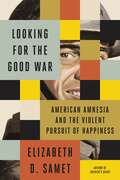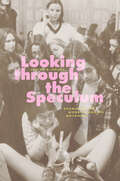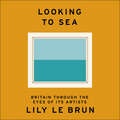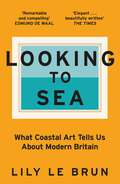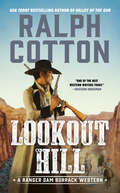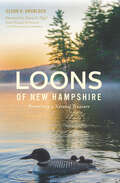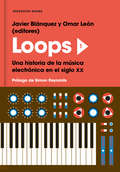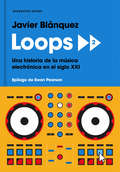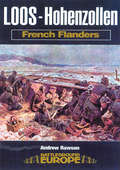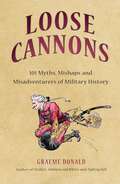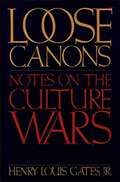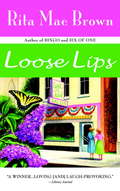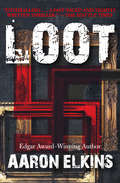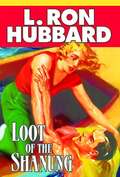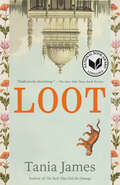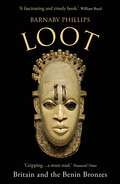- Table View
- List View
Looking for the Good War: American Amnesia and the Violent Pursuit of Happiness
by Elizabeth D. Samet"Essential reading. This eloquent, far-ranging analysis of the national psyche goes as far as any book I've ever read toward explaining the peculiar American yen for war and more war." —Ben Fountain, author of Billy Lynn's Long Halftime Walk and Beautiful Country Burn AgainIn Looking for the Good War, Elizabeth D. Samet reexamines the literature, art, and culture that emerged after World War II, bringing her expertise as a professor of English at West Point to bear on the complexity of the postwar period in national life. She exposes the confusion about American identity that was expressed during and immediately after the war, and the deep national ambivalence toward war, violence, and veterans—all of which were suppressed in subsequent decades by a dangerously sentimental attitude toward the United States’ “exceptional” history and destiny. Samet finds the war's ambivalent legacy in some of its most heavily mythologized figures: the war correspondent epitomized by Ernie Pyle, the character of the erstwhile G.I. turned either cop or criminal in the pulp fiction and feature films of the late 1940s, the disaffected Civil War veteran who looms so large on the screen in the Cold War Western, and the resurgent military hero of the post-Vietnam period. Taken together, these figures reveal key elements of postwar attitudes toward violence, liberty, and nation—attitudes that have shaped domestic and foreign policy and that respond in various ways to various assumptions about national identity and purpose established or affirmed by World War II.As the United States reassesses its roles in Afghanistan and the Middle East, the time has come to rethink our national mythology: the way that World War II shaped our sense of national destiny, our beliefs about the use of American military force throughout the world, and our inability to accept the realities of the twenty-first century’s decades of devastating conflict.
Looking through the Speculum: Examining the Women’s Health Movement
by Judith A. HouckHighlights local history to tell a national story about the evolution of the women’s health movement, illuminating the struggles and successes of bringing feminist dreams into clinical spaces. The women’s health movement in the United States, beginning in 1969 and taking hold in the 1970s, was a broad-based movement seeking to increase women’s bodily knowledge, reproductive control, and well-being. It was a political movement that insisted that bodily autonomy provided the key to women’s liberation. It was also an institution-building movement that sought to transform women’s relationships with medicine; it was dedicated to increasing women’s access to affordable health care without the barriers of homophobia, racism, and sexism. But the movement did not only focus on women’s bodies. It also encouraged activists to reimagine their relationships with one another, to develop their relationships in the name of personal and political change, and, eventually, to discover and confront the limitations of the bonds of womanhood. This book examines historically the emergence, development, travails, and triumphs of the women’s health movement in the United States. By bringing medical history and the history of women’s bodies into our emerging understandings of second-wave feminism, the author sheds light on the understudied efforts to shape health care and reproductive control beyond the hospital and the doctor’s office—in the home, the women’s center, the church basement, the bookshop, and the clinic. Lesbians, straight women, and women of color all play crucial roles in this history. At its center are the politics, institutions, and relationships created by and within the women’s health movement, depicted primarily from the perspective of the activists who shaped its priorities, fought its battles, and grappled with its shortcomings.
Looking to Sea: Britain Through the Eyes of its Artists
by Lily Le BrunLooking to Sea is an alternative history of Britain in the twentieth century, told through the prism of ten iconic artworks of the sea, one for each decade.'We see nothing truly until we understand it.' John ConstableAn alternative history of Britain in the twentieth century, Looking to Sea is an exquisite work of cultural, artistic and philosophical history.From Vanessa Bell's Studland Beach, one of the first modernist paintings in Britain, to Paul Nash's work bearing the scars of his experience in the trenches and Martin Parr's photographs of seaside resorts in the 1980s that tackle ideas of class and deprivation, Looking to Sea embraces ideas from modernism and the sublime, the impact of the world wars and colonialism, to issues crucial to our world today like the environment and nationhood.Looking to Sea is an astonishingly perceptive portrait of the twentieth century. Art critic Lily Le Brun brings a fresh eye, acute observation and challenges the reader to find a new way to look at the history of our island nation.'Looking to Sea is a remarkable and compelling book. It is both a wonderfully sustained mapping of the intersection between artists, writers and the sea and a meditation on belonging and displacement. I loved it.' Edmund de Waal(P) 2022 Hodder & Stoughton Limited
Looking to Sea: Britain Through the Eyes of its Artists
by Lily Le Brun*One of The Times Best Art Books of the Year*'Looking to Sea is a remarkable and compelling book... I loved it.' Edmund de Waal'In her first, transporting book, Lily Le Brun sweeps the beaches of the past century of British art, collecting treasures from sea, shingle and shore... A book to pack in your picnic basket for shivering dips, heatwave day trips and ice-cream Sundays' The TimesAn alternative history of modern Britain, Looking to Sea is an exquisite work of cultural, artistic and philosophical storytelling. Looking to Sea considers ten pivotal artworks, from Vanessa Bell's Studland Beach, one of the first modernist paintings in Britain, to Paul Nash's work bearing the scars of his experience in the trenches and Martin Parr's photographs of seaside resorts in the 1980s, which raised controversial questions of class. Each of the startlingly different pieces, created between 1912 and 2015, opens a window onto big ideas, from modernism and the sublime, the impact of the world wars and colonialism, to issues crucial to our world today like the environment and nationhood. In this astonishingly perceptive portrait of the twentieth century, art critic Lily Le Brun brings a fresh eye to a vast idea, offering readers an imaginative new way of seeing our island nation.'Le Brun's writing is at once bold and delicate, far-reaching and fine-tuned. Her book explores the inexhaustible variety of human perception.' Alexandra Harris'A smart and clear-eyed set of meditations on marine gaze, made with a painterly touch worthy of the chosen artists. Empathy and intelligence lift memoir into cultural history.' Iain Sinclair'Elegant and endlessly interesting . . . as much a rich compendium of social history as it is a hard consideration of art itself' Critic
Looking to the Future (Bregdan Chronicle Series #11)
by Ginny Dye‘Looking to the Future’ is the eleventh book in the Bregdan Chronicles series. How will America, and the characters you have come to love, continue to heal from the backlash of the Civil War? Carrie travels to Philadelphia to fulfill a promise, but is stunned by what she discovers, and is thrown into a world she knows nothing about. Moses and Rose are moving forward in college, but will Moses make a different decision? How will Felicia handle the challenges? Jeremy and Marietta receive the surprise of their life, forcing them to make a decision they hoped they would not have to make. Matthew and Janie welcome a new child at the same time Matthew deals with great turmoil. When everyone really just wants a simple, clear future, each person finds they have to make the choice every single day to Look To The Future. Volume # 11 of the Bregdan Chronicles continues the sweeping historical saga that now encompasses the fourth year of American Reconstruction.
Lookout Hill
by Ralph CottonONE BAD TURN DESERVES ANOTHER Arizona Ranger Sam Burrack is deep in Old Mexico, tracking two of the most heinous outlaws it’s ever been his bad luck to track. Hodding “Hot Aces” Siebert and Bobby Hugh Bellibar have nine bank robberies, three train hijackings, and more than a dozen payroll raids to their names. And they’ve left an undertaker’s fortune in dead bodies all along the border country. But there is no honor among thieves. When the pair is caught in a tight spot, Bellibar turns on his old pal Siebert like a snake, sparking a blood feud that makes it even more dangerous for Burrack to bring them in—and nearly impossible for him to get out alive… .
Loons of New Hampshire: Preserving a Natural Treasure (Natural History)
by Glenn A. KnoblockNoted for its stunning plumage and haunting cries, the common loon is an iconic symbol of nature in the Granite State. Once a familiar site on local ponds and lakes, by the early twentieth century their numbers had dwindled due to human activity. By the 1970s less than two hundred remained. It was only with the formation of the Loon Preservation Committee in 1975 by pioneer conservationist Rawson Wood that the plight of loons in New Hampshire changed for the better. Author Glenn Knoblock, in collaboration with leading experts from the organization, reveals the sometimes-mysterious nature of this beloved bird, its presence throughout the state's history, the threats it faces today and the extensive efforts to recover the population. The Loon Preservation Committee is the only organization in New Hampshire working directly on their behalf. A portion of the proceeds of the sales of this book will go directly to the organization to fund ongoing conservation efforts.
Loops 1: Una historia de la música electrónica en el siglo XX
by Javier Blánquez Omar MoreraVuelve la Biblia de la música electrónica. Una edición revisada y ampliada de una obra que marcó una época. El regreso más esperado por los fans de la música electrónica. <P><P>Loops es una obra pionera que marcó un antes y un después cuando se publicó en el año 2000. Ahora vuelve revisada y ampliada, fiel a ese primer estudio apasionado sobre el nacimiento y la evolución de un género único. Cubriendo todo el siglo XX, Loops trata con idéntica pasión las expresiones electrónicas más difíciles y las relacionadas con el fenómeno de la música de baile. <P><P>Sus autores trazan conexiones entusiastas con el universo del pop, el rock, el cine y la literatura para explicar el cómo y el porqué de la electrónica. Obra de una decena de periodistas, productores y DJ, éste pretende ser un libro de múltiples lecturas; una guía o introducción básica para el no iniciado, un volumen que ayuda a buscar pistas, a seleccionar escuchas en función de gustos, y a la vez un trabajo que pueda ampliar datos y conocimientos al ya iniciado o incluso al experto. Reseñas:«Uno de los intentos más serios realizados en nuestro país por ofrecer una visión panorámica sobre la música electrónica.»El País «Interesante, divertido, exhaustivo y excelentemente documentado.»Ricard Robles, codirector del Festival Sónar «Una obra imprescindible para entender la música que escuchamos.»Ángel Molina
Loops 2: Una historia de la música electrónica en el siglo XXI
by Javier BlánquezUna historia intensa y apasionada sobre el último siglo de un género musical que hipnotiza a multitudes: la música electrónica. Loops 2 retoma la historia de la música electrónica dónde la dejó el primer volumen, una obra canónica para los amantes del género. <P><P> Desde 2002 hasta la actualidad, el periodista Javier Blánquez cubre la transformación de un estilo musical que en los últimos quince años ha dejado de ser minoritario para formar parte del relato cultural del siglo XXI. <P>Todo ha evolucionado a un ritmo frenético: los hábitos de consumo han cambiado raves por festivales y clubes por teléfonos móviles, la técnica ofrece más opciones que nunca, la aparición de nuevas corrientes es constante y la electrónica ha colonizado prácticamente todos los géneros a su alrededor. <P> Esta obra nace de un trabajo meticuloso y entusiasmado que plantea un sinfín de preguntas que apelarán a aficionados y neófitos por igual: ¿es el reggaetón música electrónica? ¿Lo es el último disco de Madonna con referencias veladas al éxtasis? ¿Va por libre el hip hop? ¿Y el rock, se puede bailar? Y, en el centro del debate: ¿cuál es la verdadera identidad de este género en pleno siglo XXI? ¿Realmente lo hemos visto todo?
Loos: French Flanders (Battleground Europe)
by Andrew RawsonIn September 1915 Kitcherner's men were in action for the first time in the largest offensive of the year. Using gas, British troops managed to open a three mile gap in the German line. However, misuse of the reserves allowed the chance of success to pass by. In the following struggle for Hohenzollern Redboubt, the British were defeated time after time by superior weapons and tactics. For the first time visitors will be able to explore this key battle, a battle that cost the BEF over 50,000 casualties.
Loose Cannons: 101 Things They Never Told You About Military History
by Graeme DonaldFrom the author of Sticklers, Sideburns, and Bikinis comes this funny, often irreverent look at two thousand years of lies, inaccuracies, propaganda, deceit, downright foolishness, and little-known facts from the ars militaria. On Hitler: "[No one] ever produced 'proof' of Hitler having won the Iron Cross, Second Class without which the First Class could not be awarded. He was a liar, but his favorite WWI yarn, about his life being spared by a British soldier who had him dead in his sights, is unfortunately true. It seems we have Private Henry Tandy VC, then of the Green Howards, to thank for all the fun of Round 2 with Germany." On Che Guevara: "The darling of week-end rebels and champagne socialists, Guevara continues to be lauded by the intellectually bankrupt who sport his image on T-shirts, making Guevara the only racist, mass murderer to become a fashion-accessory. He neither lived nor died a hero and almost everything trumpeted about him is false." On the Lusitania: She was not an American liner; she was not sunk on her maiden voyage; she was not an 'innocent' sunk without warning by the nasty Germans; the incident was not responsible for America's entry into WW1, and as for British connivance into her sinking, the jury is still out on that. On breast enhancement surgery: One of the more unusual 'developments' from WWII, to say the least, but modern breast enhancement techniques were a direct result of the American occupation of post-war Japan.
Loose Canons: Notes on the Culture Wars
by Henry Louis GatesMulticulturalism. It has been the subject of cover stories in Time and Newsweek , as well as numerous articles in newspapers and magazines around America. It has sparked heated jeremiads by George Will, Dinesh D'Sousa, and Roger Kimball. It moved William F. Buckley to rail against Stanley Fish and Catherine Stimpson on "Firing Line." It is arguably the most hotly debated topic in America today--and justly so. For whether one speaks of tensions between Hasidim and African-Americans in Crown Heights, or violent mass protests against Moscow in ethnic republics such as Armenia, or outright war between Serbs and Croats in Yugoslavia, it is clear that the clash of cultures is a worldwide problem, deeply felt, passionately expressed, always on the verge of violent explosion. <p><p>Problems of this magnitude inevitably frame the discussion of "multiculturalism" and "cultural diversity" in the American classroom as well. In Loose Canons , one of America's leading literary and cultural critics, Henry Louis Gates, Jr., offers a broad, illuminating look at this highly contentious issue. Gates agrees that our world is deeply divided by nationalism, racism, and sexism, and argues that the only way to transcend these divisions--to forge a civic culture that respects both differences and similarities--is through education that respects both the diversity and commonalities of human culture. His is a plea for cultural and intercultural understanding. (You can't understand the world, he observes, if you exclude 90 percent of the world's cultural heritage.) <p><p>We feel his ideas most strongly voiced in the concluding essay in the volume, "Trading on the Margin." Avoiding the stridency of both the Right and the Left, Gates concludes that the society we have made simply won't survive without the values of tolerance, and cultural tolerance comes to nothing without cultural understanding. Henry Louis Gates is one of the most visible and outspoken figures on the academic scene, the subject of a cover story in The New York Times Sunday Magazine and a major profile in The Boston Globe , and a much sought-after commentator. And as one of America's foremost advocates of African-American Studies (he is head of the department at Harvard), he has reflected upon the varied meanings of multiculturalism throughout his professional career, long before it became a national controversy. <p><p>What we find in these pages, then, is the fruit of years of reflection on culture, racism, and the "American identity," and a deep commitment to broadening the literary and cultural horizons of all Americans.
Loose Lips (Runnymede #3)
by Rita Mae BrownIf you crossed Mitford, North Carolina, with Peyton Place, you might come up with Runnymede, Maryland, the most beguiling of Southern towns. In Loose Lips, Rita Mae Brown revisits Runnymede and the beloved characters introduced in Six of One and Bingo, serving up an exuberant portrayal of small-town sins and Southern mores, set against a backdrop of homefront life during World War II. "I'm afraid life is passing me by," Louise told her sister. "No, it's not," Juts said. "Life can't pass us by. We are life." In the picturesque town of Runnymede, everyone knows everyone else's business, and the madcap antics of the battling Hunsenmeir sisters, Julia (Juts) and Louise, have kept the whole town agog ever since they were children. Now, in the fateful year of 1941, with America headed for war, the sisters are inching toward forty... and Juts is unwise enough to mention that unspeakable reality to her sister. The result is a huge brawl that litters Cadwalder's soda fountain with four hundred dollars' worth of broken glass. To pay the debt, the sisters choose a surprisingly new direction. Suddenly they are joint owners of The Curl 'n' Twirl beauty salon, where discriminating ladies meet to be primped, permed, and pampered while dishing the town's latest dirt. As Juts and Louise become Runnymede's most unlikely new career women, each faces her share of obstacles. Restless Juts can't shake her longing for a baby, while holier-than-thou Louise is fit to be tied over her teenage daughter's headlong rush toward scandal. As usual, the sisters rarely see eye to eye, and there are plenty of opinions to go around. Even the common bond of patriotic duty brings wildly unexpected results when the twosome joins the Civil Air Patrol, watching the night sky for German Stukas. But loose lips can sink even the closest relationships, and Juts and Louise are about to discover that some things are best left unsaid. Spanning a decade in the lives of Louise, Juts, and their nearest and dearest, including the incomparable Celeste Chalfonte, Loose Lips is an unforgettable tale of love and loss and the way life can always throw you a curveball. By turns poignant and hilarious, it is deepened by Rita Mae Brown's unerring insight into the human heart.
Loose-leaf Version for A History of Western Society, Value Edition, Volume I
by John P. Mckay Clare Haru Crowston Merry E. Wiesner-Hanks Joe PerryPraised by instructors and students alike for its readability and attention to everyday life, A History of Western Society, Value Edition offers the full narrative of the parent text in a two-color, trade-sized text with select images and maps at an affordable price. This edition includes many tools to engage today's students and save instructors time, five chapters devoted to the lives of ordinary people that make the past real and relevant, and the best and latest scholarship throughout. Enhanced with a wealth of digital content in LaunchPad, the value edition provides easily assignable options for instructors and novel ways for students to master the content. Integrated with LearningCurve, an adaptive online resource that helps students retain the material and come to class prepared.
Loose-leaf Version for A History of Western Society, Value Edition, Volume II
by John P. Mckay Clare Haru Crowston Merry E. Wiesner-Hanks Joe PerryPraised by instructors and students alike for its readability and attention to everyday life, A History of Western Society, Value Edition offers the full narrative of the parent text in a two-color, trade-sized text with select images and maps at an affordable price. This edition includes many tools to engage today's students and save instructors time, five chapters devoted to the lives of ordinary people that make the past real and relevant, and the best and latest scholarship throughout. Enhanced with a wealth of digital content in LaunchPad, the value edition provides easily assignable options for instructors and novel ways for students to master the content. Integrated with LearningCurve, an adaptive online resource that helps students retain the material and come to class prepared.
Loot
by Aaron ElkinsIn April 1945, The Nazis, reeling and near defeat, frantically work to hide the huge store of art treasures that Hitler has looted from Europe. Truck convoys loaded with the cultural wealth of the Western world pour in an unending stream into the compound of the vast Altaussee salt mine high in the Austrian Alps. But with the Allies closing in, the vaunted efficiency of the Nazis has broken down. At Altaussee, all is tumult and confusion. In the commotion a single truck, its driver, and its priceless load of masterpieces vanish into a mountain snowstorm.Half-a-century later, in a seedy Boston pawnshop, ex-curator Ben Revere makes a stunning discovery among the piles of junk: a Velazquez from the legendary Lost Truck. But with it come decades of secrets, rancor, and lies, and the few who know of the painting's existence have their lives snuffed out one by one by an unknown assassin. Revere must travel back to the grand cities of Europe to unravel the tangled history of the lost truck and its treasures before fifty years of hatred, greed, and retribution catch up with him.
Loot of the Shanung
by L. Ron HubbardStop the presses! One hundred thousand dollar reward offered for the return of George Harley Rockham! That's more than enough to turn Shanghai newspaperman Jimmy Vance's head. Throw in the gorgeous dame who's offering the reward--Rockham's daughter Virginia--and he might lose his head altogether. As fast-talking as Jimmy Stewart in The Philadelphia Story, Vance jumps at the chance . . . the money . . . and the girl.But as Jimmy quickly discovers, there are several billion reasons to watch his back. Because that's how much Rockham is worth, and there are some very hard cases out there willing to kill to separate the old man from his money.Next thing Jimmy knows, Virginia's tied to a chair, and he's got a couple of guns pointed at his head. But it'll take more than a little rope and a couple of firearms to keep this reporter down. The truth is tied to the mysterious fate of a steamship named Shanung--and what Jimmy finds could be the biggest story of his life . . . if he lives to tell it. In the issue of Smashing Novels where this story first appeared the editor wrote: "Loot of the Shanung is a soul-stirring tale of the China Sea, a story of modern piracy set in the Far East. L. Ron Hubbard wrote it. He knows China. He has been there. He traveled through the country and met the people and observed their customs. Smashing Novels will have other stories from him--stories of far-off places and little known people. He knows of what he writes."
Loot: A novel
by Tania JamesLONGLISTED FOR THE NATIONAL BOOK AWARD IN FICTION • A spellbinding historical novel set in the eighteenth century: a hero&’s quest, a love story, the story of a young artist coming of age, and an exuberant heist adventure that traces the bloody legacy of colonialism across two continents and fifty years.&“Addictively absorbing.&” —The New York Times Book Review This wildly inventive, irresistible feat of storytelling from a writer at the height of her powers is "an expertly-plotted, deeply affecting novel about war, displacement, emigration, and an elusive mechanical tiger" (Maggie O&’Farrell, best-selling author of Hamnet and The Marriage Portrait). Abbas is just seventeen years old when his gifts as a woodcarver come to the attention of Tipu Sultan, and he is drawn into service at the palace in order to build a giant tiger automaton for Tipu&’s sons, a gift to commemorate their return from British captivity. His fate—and the fate of the wooden tiger he helps create—will mirror the vicissitudes of nations and dynasties ravaged by war across India and Europe.Working alongside the legendary French clockmaker Lucien du Leze, Abbas hones his craft, learns French, and meets Jehanne, the daughter of a French expatriate. When Du Leze is finally permitted to return home to Rouen, he invites Abbas to come along as his apprentice. But by the time Abbas travels to Europe, Tipu&’s palace has been looted by British forces, and the tiger automaton has disappeared. To prove himself, Abbas must retrieve the tiger from an estate in the English countryside, where it is displayed in a collection of plundered art.
Loot: Britain and the Benin Bronzes (Modern Classics Ser.)
by Barnaby Phillips&‘A fascinating and timely book.&’ William Boyd &‘Gripping…a must read.&’ FT In 1897, Britain responded to the killing of a group of officials by razing an empire to the ground. The men had been travelling to the ancient Kingdom of Benin, in what is now Nigeria, when they were ambushed and killed by local soldiers. Just six weeks later, the British had exacted their revenge, set Benin aflame, exiled the king and annexed the territory. They also made off with some of Africa&’s greatest works of art.This is the story of the &‘Benin Bronzes&’, their creation, removal, and what should happen to them now. When first exhibited in London they caused a sensation and helped reshape European attitudes towards Africa, challenging the prevailing view of the continent as &‘backward&’ and without culture. But seeing them in the British Museum today is, in the words of one Benin City artist, like &‘visiting relatives behind bars&’. In a time of fevered debate about the legacies of empire, loot, museums and history, what does the future hold for the Bronzes themselves?
Loot: How Israel Stole Palestinian Property
by Adam RazExiled in 1948, Palestinians were robbed of their private property when looting became weaponizedDuring the 1948 War, Israeli fighters and residents alike plundered Palestinian homes, shops, businesses, and farms. This bitter truth was then suppressed or forgotten over the coming years.Tens of thousands took part in the pillage of Palestinian property, stealing the belongings of their former neighbours. The implications of this mass looting go far beyond the personality or moral fibre of those who took part. Plundering served a political agenda by helping to empty the country of its Palestinian residents. In this context, it was part of the prevailing policy during the war – one designed to crush the Palestinian economy, destroy villages, and to confiscate and sometimes destroy crops and harvests remaining in the depopulated zones.The participating Jewish public became a stakeholder, motivated to prevent Palestinian residents from returning to the villages and cities they had left. These ordinary people were mobilized in the push for the segregation of Jews and Arabs in the early years of statehood.With painstaking original research into primary sources, Adam Raz has brought to light a tragic moment in the history of a conflict that roils the region and the wider world. As the details of the Nakba are understood and documented, redress for Palestinian grievances comes closer to reality.
Loot: The Battle Over the Stolen Treasures of the Ancient World
by Sharon WaxmanA journey across four continents to the heart of the conflict over who should own the great works of ancient artWhy are the Elgin Marbles in London and not on the Acropolis? Why do there seem to be as many mummies in France as there are in Egypt? Why are so many Etruscan masterworks in America? For the past two centuries, the West has been plundering the treasures of the ancient world to fill its great museums, but in recent years, the countries where ancient civilizations originated have begun to push back, taking museums to court, prosecuting curators, and threatening to force the return of these priceless objects.Where do these treasures rightly belong? Sharon Waxman, a former culture reporter for The New York Times and a longtime foreign correspondent, brings us inside this high-stakes conflict, examining the implications for the preservation of the objects themselves and for how we understand our shared cultural heritage. Her journey takes readers from the great cities of Europe and America to Egypt, Turkey, Greece, and Italy, as these countries face down the Louvre, the Metropolitan Museum, the British Museum, and the J. Paul Getty Museum. She also introduces a cast of determined and implacable characters whose battles may strip these museums of some of their most cherished treasures.For readers who are fascinated by antiquity, who love to frequent museums, and who believe in the value of cultural exchange, Loot opens a new window on an enduring conflict.
Looting Spiro Mounds: An American King Tut's Tomb
by David La VereVere (history, U. of North Carolina, Wilmington) recounts the looting of the Spiro Mounds in eastern Oklahoma in 1935, which contained a large amount of pre-Columbian art. He describes the founding and settlement of the area from 800 A.D., the culture and life of the people, and the decline of the chiefdom by 1450 A.D. These chapters are interwoven with the story of how the Pocola Mining Company found the Mounds in the 1930s and looted the objects, the fight with them by U. of Oklahoma's anthropologist Forrest Clements over who had property rights, Works Progress Administration excavation, and past and present theories about Spiro and its people. Annotation ©2007 Book News, Inc., Portland, OR (booknews.com)
Lopez Island
by Lopez Island Historical Society and Museum Susan Lehne FergusonThe story of Lopez Island is a story of community. Skilled, brave, generous people like Sampson Chadwick, Mother Brown, Captain Barlow, and Amelia Davis carved a spirited, nurturing community out of seaside wilderness. Homesteaders cleared forests, built farms, grew food, and raised large families, surviving then thriving together. The hamlets of Port Stanley, Richardson, and Lopez emerged, creating hubs with stores, post offices, and schools as well as thriving fishing, canning, and shipping industries. The community fostered education, music, writing, dances, chivarees, baseball, quilting, a birthday club, and grand Fourth of July celebrations. Living self-reliant lives while helping friends, neighbors, and newcomers, Lopezians created a unique community character that abides today.
Loquela
by Will Vanderhyden Carlos Labbé"Begins to fuck with your head from its very first word."--Toby Litt"Navidad & Matanza could be the hallucinogenic amalgamation of a César Aira plot with setting and characters conceived by Bolaño--if written using Oulipo-style constraints. . . . With ample imagination and commanding style, Navidad & Matanza certainly marks Labbé as a young author from whom we ought to anticipate great, fascinating things to come."--Jeremy Garber, Powell's BooksLoquela, Carlos Labbé's fourth novel and second to be translated into English, is a narrative chameleon, a shape-shifting exploration of fiction's possibilities.At a basic level, this is a distorted detective novel mixed with a love story and a radical statement about narrative art. Beyond the silence that unites and separates Carlos and Elisa, beyond the game that estranges the albino girls, Alicia and Violeta, from pleasant summer evenings, beyond the destiny of Neutria--a city that disappears with childhood--and beyond a Chilean literary movement that could be the last vanguard, while at the same time the greatest falsification, questions arise concerning who truly writes for whom in a novel--the author or the reader.Through an array of voices, overlapping storylines, a kaleidoscope of literary references, and a delirious, precise prose, Labbé carves out a space for himself among such great form-defying Latin American writers as Juan Carlos Onetti and Jorge Luis Borges.Carlos Labbé, one of Granta's "Best Young Spanish-Language Novelists," was born in Chile and is the author of a collection of short stories and six novels, one of which, Navidad & Matanza, is available in English from Open Letter. In addition to his writings, he is a musician, and has released three albums. Will Vanderhyden received an MA in literary translation from the University of Rochester.
Lorain (Images of America)
by The Black River Historical SocietyThe City of Lorain was incorporated in 1874 by the town council. It was named after the county, which had been named by Heman Ely, who thought the area looked very much like the Province of Lorraine in France. Lorainâ TMs location next to Lake Erie and theearly arrival of the B&O Railroad in 1871 made thecity a hotbed for industry. The Hayden Brass Worksbuilt a large plant on Elyria Avenue. Captain Thew, aship captain on the lakes, developed an improved gearsystem for a steam shovel, and that started the Lorain Thew Shovel Co., which became known worldwide.Lorain grew tremendously in the 1890s. Constructionof the Johnson Steel Rail Company started in 1894, and in just ten years, the population of the City of Lorain tripled. In 1894, the American Stove Works built a plant in Lorain, where they made heaters and furnaces. Three years later, the American Shipbuilding Company built a yard and launched hundreds of ships before it closed in 1984. Lorain, Ohio, certainly did its part during World War II; many men went into service, and Lorain produced its own share of heroes. The shipyard was also put to work by the government to build the USS Lorain, a frigate.
